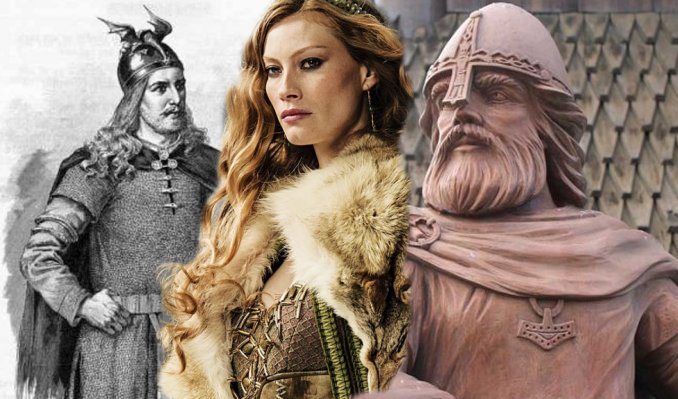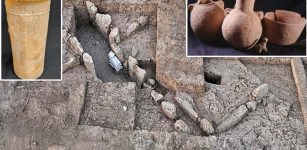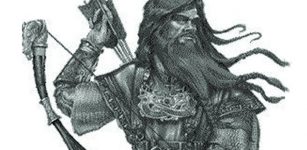Mystery Of Ivar The Boneless And Ímar – Remarkable Viking Puzzle Reveals Something Extraordinary
Ellen Lloyd - AncientPages.com - There are so many striking historical similarities between Ivar the Boneless and Ímar that some scholars suggest these two Vikings were the same person. If that is true, it's time to rewrite the history of Ivar the Boneless. Interestingly, Ímar vanished from the Irish historical records for unknown reasons at the same time Ivar the Boneless became active in England.
Could this fact possibly shed more light on the real identity of Viking Ímar? A closer examination of this historical Viking mystery reveals something extraordinary.
Viking Ímar (or Ívarr or Ivar) was the founder of the Uí Ímair dynasty, a Norse royal dynasty also known as the Dynasty of Ivar.
Being an influential Viking leader, Ímar ruled much of the Irish Sea region, the Norse Kingdom of Dublin, the western coast of Scotland, including the Hebrides, and some parts of Northern England, from the mid-9th century.
In the Fragmentary Annals of Ireland, it is written that Ímar was the son of Gofraid, King of Lochlann. We also learn from this text that Ímar had two brothers, Auisle and Amlaíb Conung. The Irish Annals also title the brothers Amlaíb, Ímar, and Auisle "kings of the foreigners" – not Irish kings but invaders.
Viking Halfdan Ragnarsson Was Brother Of Ivar the Boneless And Ímar
Turning our attention to Viking Ivar the Boneless, who we discussed in another article on Ancient Pages, we know that this enigmatic Viking was the leader of the Great Heathen Army, a coalition of Norse warriors originating from Denmark and Norway (and possibly also from Sweden). Some historians suggest Viking leader Halfdan Ragnarsson was also a brother of Ímar.

Ragnar Lodrok wanted to kill his son Ivar the Boneless against Aslaug's wishes. Read more:
They came together under a unified command.
Ivar the Boneless was the son of Ragnar Lodbrok, the fearless Sea King. Ragnar Lodrok considered himself to be a direct descendant of the god Odin and he was one of the most famous Norse heroes among the Vikings. His sons became just as renowned and heroic as he had been.
On one occasion, Lodbrok learned from a seer that he would have many famous sons. He became somewhat obsessed with this prophecy, which almost led to a tragic event when he tried to kill his son, Ivar the Boneless.
Ivar the Boneless survived his father's attempt to murder him and became one of the most famous Vikings in history.
From the Icelandic Sagas, we learn that Halfdan Ragnarsson, the brother of Ivar the Boneless. One reason to suspect that Ivar the Boneless was known in Ireland as Ímar!
Mysterious Disappearance Of Viking Ímar
During the late 850s and early 860s, Ímar became involved in a conflict with Máel Sechnaill, the Overking of the Southern Uí Néill and the most powerful ruler in Ireland.
 Artist's depiction of the landing of a Viking fleet at Dublin in 841 CE. Image credit: James Ward (1851-1924 - Public Domain
Artist's depiction of the landing of a Viking fleet at Dublin in 841 CE. Image credit: James Ward (1851-1924 - Public Domain
What really happened is unknown, but most likely, this was a struggle to gain control of Munster and its resources. In 862 AD, Máel Sechnaill died, and the conflict ended, dividing the lands of the dead Overking of the Southern Uí Néill.
Viking Ímar continued his battles and desired to expand the Norse kingdom. Then suddenly something strange happened. What happened, and where did he go? Ímar, the King of Dublin, vanished from the Irish historical records between 864 and 870 AD.
The story becomes even more interesting at this point because historical accounts state that in 865, Ivar the Boneless decided to invade England and launched the largest invasion of the British Isles in recorded history. His brothers Halfdan and Ubba and his colleague Olaf the White Ivar the Boneless sailed from Dublin and landed in East Anglia.
So, it's very likely that Ímar, Ivar the Boneless, sailed from Ireland to England, which is why he was not mentioned in Irish chronicles.
Dumbarton Rock. Illustration by T. Nelson (1892)
However, in the year 870 AD, Ímar reappeared in Irish records. According to the Irish annals, following a four-month-long siege, Ímar and Amlaíb captured Dumbarton Rock, the chief fortress of the kingdom of Strathclyde.
Both Vikings Ivar the Boneless and Ímar died in Ireland in 873 AD. Viking Ímar was given the title "King of the Norsemen of all Ireland and Britain" in contemporary annals.
Whose Descendants? Remarkable Viking Puzzle
Everything indicates Ivar the Boneless was known under a different name in Ireland. The similarities between these two Vikings are remarkable. They died the same year in the same country. They had a brother with the same name and made identical journeys, but unlike Ivar the Boneless, who historians suspect was impotent, Viking Ímar had descendants!
It means that there are two possibilities. Historians could be wrong in claiming that Ivar the Boneless was impotent, or, despite these similarities, we can assume that Ivar the Boneless and Ímar were two completely different persons who lived almost identical lives for some unknown reasons!
Updated on March 5, 2024
Written by - Ellen Lloyd – AncientPages.com
Copyright © AncientPages.com All rights reserved. This material may not be published, broadcast, rewritten or redistributed in whole or part without the express written permission of AncientPages.com
Expand for referencesMore From Ancient Pages
-
 First Fossils Of Ancient Human Relatives Sent To Space – Tribute To Science And Our Ancient History
Fossils | Sep 12, 2023
First Fossils Of Ancient Human Relatives Sent To Space – Tribute To Science And Our Ancient History
Fossils | Sep 12, 2023 -
 Surprising Time Capsule In Antarctica – Evidence Of Toxic Heavy Metal Pollution 800 Years Ago
Earth Changes | Jan 18, 2024
Surprising Time Capsule In Antarctica – Evidence Of Toxic Heavy Metal Pollution 800 Years Ago
Earth Changes | Jan 18, 2024 -
 Clothing And Jewelry In Ancient Egypt – How Did The Ancient Egyptians Dress?
Ancient History Facts | Jun 7, 2020
Clothing And Jewelry In Ancient Egypt – How Did The Ancient Egyptians Dress?
Ancient History Facts | Jun 7, 2020 -
 Mysterious Runes Deciphered By School Children In Sweden Shed New Light On The Kensington Stone
Artifacts | Oct 4, 2019
Mysterious Runes Deciphered By School Children In Sweden Shed New Light On The Kensington Stone
Artifacts | Oct 4, 2019 -
 Ancient 5,500-Year-Old Gate Was Discovered Recently At Tell Erani, Near The Kiryat Gat Industrial Zone, Israel
Archaeology | Aug 17, 2023
Ancient 5,500-Year-Old Gate Was Discovered Recently At Tell Erani, Near The Kiryat Gat Industrial Zone, Israel
Archaeology | Aug 17, 2023 -
 Comet Strike 13,000 Years Ago May Have Changed Human Civilization
Archaeology | Jul 6, 2021
Comet Strike 13,000 Years Ago May Have Changed Human Civilization
Archaeology | Jul 6, 2021 -
 Unique Gold Votive Plaque Found At Fort Apsaros Reveals Evidence Of A Mysterious Roman Sect
Archaeology | Nov 14, 2024
Unique Gold Votive Plaque Found At Fort Apsaros Reveals Evidence Of A Mysterious Roman Sect
Archaeology | Nov 14, 2024 -
 New Chemical Reactions To Generate Building Blocks Of Proteins And DNA – Discovered
DNA | Jul 29, 2022
New Chemical Reactions To Generate Building Blocks Of Proteins And DNA – Discovered
DNA | Jul 29, 2022 -
 Bolivia And The Mystery Of The Twins Of Atlantis
Featured Stories | Nov 16, 2014
Bolivia And The Mystery Of The Twins Of Atlantis
Featured Stories | Nov 16, 2014 -
 Tavern And Mysterious Tools Discovered In North Carolina – Stunning Ancient Time Capsule
Archaeology | Jun 19, 2019
Tavern And Mysterious Tools Discovered In North Carolina – Stunning Ancient Time Capsule
Archaeology | Jun 19, 2019 -
 On This Day In History: The Battle Of Fulford – King Hardrada Against Saxon Troops – Was Fought – On Sep 20, 1066
News | Sep 20, 2016
On This Day In History: The Battle Of Fulford – King Hardrada Against Saxon Troops – Was Fought – On Sep 20, 1066
News | Sep 20, 2016 -
 Unique 8,400-Year-Old Burial Of A Dog Different From Modern Dogs Discovered In Sweden
Archaeology | Sep 25, 2020
Unique 8,400-Year-Old Burial Of A Dog Different From Modern Dogs Discovered In Sweden
Archaeology | Sep 25, 2020 -
 Klerksdorp Spheres – Controversial And Out-Of-Place In Time Metallic Spheres From South Africa
Artifacts | Apr 8, 2017
Klerksdorp Spheres – Controversial And Out-Of-Place In Time Metallic Spheres From South Africa
Artifacts | Apr 8, 2017 -
 Goddess Huitaca – Moon Goddess Of Intoxication, Joyful Life And Unlimited Pleasures In Muisca Mythology
Featured Stories | Mar 14, 2021
Goddess Huitaca – Moon Goddess Of Intoxication, Joyful Life And Unlimited Pleasures In Muisca Mythology
Featured Stories | Mar 14, 2021 -
 Cursed Biblical City Bethsaida May Have Been Found – But Scientists Argue About The Discovery
Archaeology | Sep 1, 2020
Cursed Biblical City Bethsaida May Have Been Found – But Scientists Argue About The Discovery
Archaeology | Sep 1, 2020 -
 Roman Britain Executions Revealed – New Evidence
Archaeology | Aug 14, 2021
Roman Britain Executions Revealed – New Evidence
Archaeology | Aug 14, 2021 -
 We Dated A Sacred Aboriginal Women’s Site Used for Birthing Ceremonies And Discovered 7,000 Years Of Tool Making
Featured Stories | Jun 21, 2024
We Dated A Sacred Aboriginal Women’s Site Used for Birthing Ceremonies And Discovered 7,000 Years Of Tool Making
Featured Stories | Jun 21, 2024 -
 Solstices Brought Mayan Communities Together, Using Monuments Shaped By Science And Religion – And Kingly Ambitions, Too
Featured Stories | Jul 6, 2024
Solstices Brought Mayan Communities Together, Using Monuments Shaped By Science And Religion – And Kingly Ambitions, Too
Featured Stories | Jul 6, 2024 -
 Vali – Son Of Odin, Who Avenged Death Of Balder And Survived Ragnarok
Featured Stories | Aug 29, 2019
Vali – Son Of Odin, Who Avenged Death Of Balder And Survived Ragnarok
Featured Stories | Aug 29, 2019 -
 Amazing Photos Of Ancient Ruins Hidden Under Thessaloniki Metro Revealed By Archaeologists
Archaeology | Jan 9, 2023
Amazing Photos Of Ancient Ruins Hidden Under Thessaloniki Metro Revealed By Archaeologists
Archaeology | Jan 9, 2023


